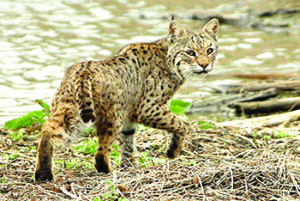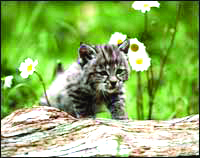By Dr. Beth Leermakers
Is that a really big cat on your roof, or could it be a bobcat? Your eyes aren’t deceiving you. Bobcats may be living in your North Texas neighborhood. A friend — and his German Shepherds — recently spotted a bobcat in his fenced yard in Coppell.

Photos courtesy of Chris Jackson/Texas Parks and Wildlife
According to a 2019 study by the Texas Parks and Wildlife Department, there were about 43 bobcats living in a 50-mile stretch of Dallas/Fort Worth, including Dallas, Fort Worth, Arlington, Hurst, Bedford, Euless and Grand Prairie. City-dwelling bobcats tend to stay in more natural areas near parks, creeks and floodplains. Dallas is appealing to bobcats because of the Trinity River, which provides many types of food, plenty of water and a large area of protection.
Biologist Richard Heilbrun and the other researchers discovered a primary difference between rural and urban bobcats — their diet. Rural bobcats mostly eat rabbits and hares, and they also eat rodents (rats and squirrels) or hunt small deer, snakes and lizards. Urban bobcats focus more on eating rodents. In North Texas, bobcats mostly eat rats, mice, squirrels, ducks and cardinals. Heilbrun and his team collected bobcats that had been killed by cars and examined what was inside their stomachs. They found 23 rats in one cat! City bobcats are “eating those urban, invasive non-native rats, so they’re actually providing a service for our human residents,” Heilbrun said.
Bobcats are Not Dangerous
The good news for concerned pet parents is that bobcats prefer wild food to pet food — or pets — and usually hide in the woods. The wild cats are nonconfrontational, so it’s unlikely they will interact with people or small animals. “Bobcats typically don’t get into those types of conflicts, and they really don’t like interacting with people, so they’re not a dangerous wild animal,” Heilbrun said. The only exception to this is when people start feeding a bobcat or treating it like a pet. As long as you are not leaving food out for the animal, bobcats will most likely find everything they need in nearby natural areas.
How can you identify a bobcat? They are about twice the size of domestic cats, with longer legs. They are about 25-35 inches long, with the males weighing an average of 26 pounds and females, 20 lbs. These wild felines have short tails (giving them their name) and tufts of hair on the tips of their ears. The tufts may enhance their hearing.
Bobcats are solitary, territorial animals that are crepuscular (most active at dawn and dusk). Females never share their territory (about five square miles) with other females, but males’ territories (25-30 square miles) tend to overlap. A male bobcat’s home range overlaps that of several females, and males will mate with more than one female.
Bobcats are well adapted for hunting. They are excellent climbers, often using lookout trees to survey their territory, and can run up to 30 miles per hour. They place their back feet in the same spots where their front feet landed to reduce noise while hunting. They patiently stalk their prey, often traveling two to seven miles at night while hunting and patrolling their territory. Keen eyesight lets them see slight movements in the dark.

Bobcats usually mate in the winter, but breeding can occur between November and August. Most kittens are born in the spring, and litters have two to four kittens. The mother nurses her kittens for two months and travels with them for three-to-five months, teaching them to hunt at five months. She kicks them out of her territory before the winter mating season. The backs of a bobcat’s ears have two white spots, which a female’s kittens probably follow in dim light. The white underside of the bobcat’s bobbed tail also helps kittens follow their mother in the dark. If kittens fall too far behind their mother, the mother stops and softly calls to them while raising her tail to reveal the white patch below.
Co-existing with Bobcats
According to DFW Wildlife (dfwwildlife.org/bobcat/), bobcats need to remain afraid of people. Follow these tips to coexist peacefully with bobcats:
1. Do NOT feed them — or any wildlife. Contact a wildlife rehabilitation expert if you find an injured animal.
2. Protect your small pets. Pets the size of a rabbit or smaller are considered prey by bobcats, coyotes, hawks, owls and other predators. Keep your cats indoors, and don’t let your small dog go outside (even in your fenced yard) unattended at night. Remember, bobcats are good climbers, so a fence won’t deter them.
3. When you see a bobcat, make the encounter unpleasant for the cat. Shout, bang pots and pans, throw a rock, or squirt water from a hose. Bobcats naturally avoid people. By hazing them, you keep them from getting too comfortable in your yard.
4. When walking or running, raise your arms (to appear larger) and yell while looking directly at the bobcat. Or carry a whistle or bicycle horn to scare the bobcat.
5. Do NOT run away from a bobcat. Running encourages the wild kitty to chase you.
6. Never corner a bobcat or any wild animal. Provide an escape route for the animal.
If you want to see a bobcat up close, in a safe environment, visit In Sync Exotics in Wylie (insyncexotics.org).
